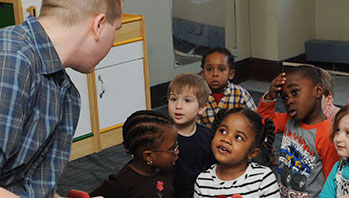- community
- garden
- plants
MA Standards:
Speaking and Listening/SL.PK.MA.1: Participate in collaborative conversations with diverse partners during daily routines and play.
Language/L.PK.MA.6: Use words and phrases acquired through conversations, listening to books read aloud, activities, and play.
Head Start Outcomes:
Language Development/Receptive Language: Attends to language during conversations, songs, stories, or other learning experiences.
Language Development/Expressive Language: Uses language to express ideas and needs.
PreK Learning Guidelines:
English Language Arts/Language 2: Participate actively in discussions, listen to the ideas of others, and ask and answer relevant questions.
Talk Together: Community Gardens

© Commonwealth of Massachusetts, Department of Early Education and Care (Jennifer Waddell photographer). All rights reserved.
STEM Key Concepts: Respect the environment and do not harm plants and other living things; Plants grow in many places; Plants exhibit diversity and variation
ELA Focus Skills: Listening and Speaking, Vocabulary
Ask children if they have grown any plants at home or if they know of anyone who grows plants in a garden. Introduce the concept of people sharing gardening space. Tell children there are people who don’t have space to plant a garden at home, so they share an area with others in their neighborhood or community.
- Introduce the concept of “community.” Explain to children that a “community” is a group of people who have something in common. For example, people who live in the same neighborhood are part of the same “community.” Children in the same classroom are part of the same “community.” When people share a community garden, it means that people prepare and take care of the garden together and they share the plants in the garden.
- Tell children that often people have a community garden in neighborhoods where there is not enough land for people to have their own gardens.
Social Emotional Tip: As children share and discuss their ideas, they practice following basic conversational rules, such as taking turns, staying on topic, and actively listening.
